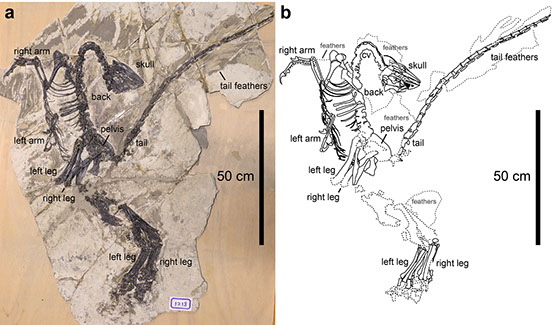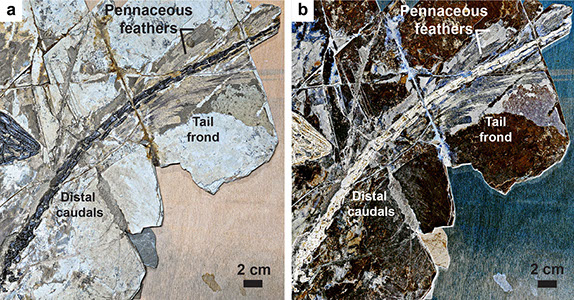
Jurassic Spark
New work using high-powered lasers to examine fossils has yielded a more accurate picture than ever of their true appearance. While fossils and skeletal remains imply what dinosaurs must have looked like, this new laser technique reveals images of soft tissue preserved as chemical signatures.
Dr Michael Pittman from the Department of Earth Sciences and his international team are the first to use Laser-Stimulated Fluorescence (LSF) imaging to reconstruct dinosaur appearance, and their study is a landmark in our understanding of the biology and origins of birds and of how flight evolved.
“We used high-powered lasers to reveal unseen soft tissues preserved alongside the bones of a feathered dinosaur called Anchiornis,” said Dr Pittman. The technique involves sweeping laser light across a specimen in a dark room while taking long-exposure photos with a camera. The resulting images reveal soft tissue details that are otherwise invisible under normal light.
“LSF involves shining violet-coloured laser light on the specimen. Energy goes in and interacts with the fossil, and then some leaves the fossil as fluorescence, giving us multi-coloured pictures. It is the impurities in the minerals making up the fossils that the laser light interacts with, and this process can give off light which we see as fluorescence,” he said, before adding: “This technique is not a magic wand – you don’t always get fluorescence. And, it requires specimens with exceptional preservation. Of the around 230 Anchiornis specimens we studied, we only reported 12 with pristine soft tissue preservation. But those 12 were stunning.”
The implications are major for questions about flight origins, particularly powered flight. “Microraptor is a bird-like dinosaur that was capable of gliding as well as flapping its arms to aid its movement, which probably included ability for powered flight. This is a major reason why scientists are now wondering if powered flight evolved more than once. Anchiornis lived 35 million years earlier than Microraptor and is seen as either a bird-like dinosaur or an early bird. We found that Anchiornis has a mixture of both primitive and advanced wing characteristics, providing important details about the diversity of wing anatomies present at the time when flight was first developing,” said Dr Pittman.
“Before, with feathered dinosaurs like Microraptor, we had to rely heavily on modern birds to estimate their wing shape. Our laser imaging shows the actual wing outline which supplies important calibration data for body shape estimates in feathered non-avian dinosaurs and early birds. This enables future work to improve on what we know about how they moved and transitioned to flight. The caveat is that we have only studied one animal so far. Extending this work to more recent fossil birds with more developed wing anatomy is particularly important as it will deepen our understanding of how early flyers refined their abilities towards those we see today.”
Traditionally, dinosaur shape has been determined by taking a dinosaur skull or skeleton, comparing it with living animals and then making an educated guess. “Some fossils preserve tissue and feathers, including close relatives of T rex,” said Dr Pittman, “and so we can correlate from modern animals where bones went and reconstruct muscle patterns, and from this we can work out how dinosaurs moved. For bird-like dinosaurs we can make comparisons with living birds as well as crocodilians – birds being the only living dinosaurs and crocodilians are their closest living dinosaur relatives.
But for some such as Stegosaurus, they are not bird-like, so comparisons with birds aren’t
very helpful.”
The laser equipment used by the team is surprisingly small – about the size of a dim sum steamer – and therefore highly portable. It was developed by Thomas G Kaye, Director of the Foundation for Scientific Advancement in Arizona, USA, who has been collaborating with Dr Pittman since 2014. On a recent visit to several European universities and museums, a researcher in Spain told Dr Pittman and Mr Kaye she was stunned by the detail revealed by the laser on a specimen she had studied for almost a decade.
New dinosaur
Dr Pittman’s investigations have also led to the discovery of a new species of dinosaur with interesting feathering that may hold answers to some of the questions regarding the early function of feathers and its role in flight development.
The new species, Jianianhualong tengi, is part of a family of bird-like dinosaurs called troodontids, which together with dromaeosaurids (Velociraptor and its kin) are the closest relatives to birds (these animals are collectively called paravians). Discovered in Liaoning province in northeastern China, the new dinosaur would have lived around 125 million years ago.
What is important about the discovery is that Jianianhualong tengi possessed asymmetrical feathers, the first time these have been recorded in troodontid dinosaurs.
“This is the first unequivocal troodontid with feathers,” said Dr Pittman. “What’s more, it has asymmetrical feathers. While we can’t use this as a diagnostic tool for flight ability because some recently flightless birds still have asymmetrical feathers, this new evidence indicates that asymmetrical feathers were present in the first paravians (birds, troodontids and dromaeosaurids) at least 160 million years ago, raising important questions about what was going on at that time. Therefore, despite the uncertainty surrounding the early function of asymmetrical feathers, we contribute a big piece to the puzzle.”
Next
Back
Life reconstruction of the asymmetrically feathered troodontid Jianianhualong tengi.
(Courtesy of Julius T Csotonyi, Xu, Currie, Pittman et al)
The asymmetrically feathered troodontid Jianianhualong tengi. (a) Photograph, and (b) line drawing of the fossil specimen.
(Courtesy of Xu, Currie, Pittman et al)
An asymmetrical tail feather from the troodontid Jianianhualong tengi. (a) Photograph, and (b) line drawing of the fossil feather.
(Courtesy of Xu, Currie, Pittman et al)
The tail frond of the troodontid Jianianhualong tengi. (a) Photograph, and (b) laser-stimulated fluorescence image of the fossil tail frond.
(Courtesy of Xu, Currie, Pittman et al)

-crop-u14292.jpg?crc=4138612084)
Dr Michael Pittman
![]() Before, with feathered dinosaurs like Microraptor, we had to rely heavily on modern birds to estimate their wing shape. Our laser imaging shows the actual wing outline which supplies important calibration data for body shape estimates in feathered non-avian dinosaurs and early birds.
Before, with feathered dinosaurs like Microraptor, we had to rely heavily on modern birds to estimate their wing shape. Our laser imaging shows the actual wing outline which supplies important calibration data for body shape estimates in feathered non-avian dinosaurs and early birds. ![]()




